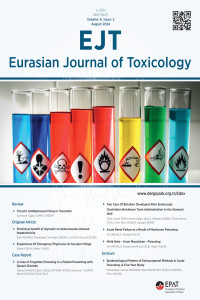Öz
Kaynakça
- Kwakye GF, Jiménez J, Jiménez JA, Aschner M. Atropa belladonna neurotoxicity: Implications to neurological disorders. Food and Chemical Toxicology. 2018;116:346-53.
- Fatur K, Kreft S. Common anticholinergic solanaceaous plants of temperate Europe-A review of intoxications from the literature (1966–2018). Toxicon. 2020;177:52-88.
- Lee M. Solanaceae IV: Atropa belladonna, deadly nightshade. Journal-Royal College of Physicians of Edinburgh. 2007;37(1):77.
- Berdai MA, Labib S, Chetouani K, Harandou M. Case report- Atropa Belladonna intoxication: a case report. Pan African medical journal. 2012;11(1).
- Towler DA, Havlin CE, Craft S, Cryer P. Mechanism of awareness of hypoglycemia: perception of neurogenic (predominantly cholinergic) rather than neuroglycopenic symptoms. Diabetes. 1993;42(12):1791-8.
- Soulaidopoulos S, Sinakos E, Dimopoulou D, Vettas C, Cholongitas E, Garyfallos A. Anticholinergic syndrome induced by toxic plants. World journal of emergency medicine. 2017;8(4):297.
- Demir C, Dülger C, Mete R, Arslan Ş, Dilek İ. Atropa belladonna ile zehirlenme: Bir olgu sunumu. Van Tıp Dergisi. 2006;13(2):61-3.
- Rumack BH. Anticholinergic poisoning: treatment with physostigmine. Pediatrics. 1973;52(3):449-51.
Öz
Anticholinergic poisoning is one of the most common causes of poisoning in the emergency department. Beautiful hawthorn (atropa belladonna), which is found in our country, is one of the plants that can cause anticholinergic syndrome. It is important in the differential diagnosis in cases progressing with general status disorder and loss of consciousness and psychotic findings. The onset of anticholinergic intoxication varies depending on the toxin and occurs within one to two hours following oral ingestion. The diagnosis of anticholinergic poisoning is based on clinical findings. Anticholinergic poisoning is easily diagnosed when a history of exposure to an anticholinergic substance is obtained and the patient shows altered mental status, delirium or hallucinations. However, in cases with no history and unknown exposure, the diagnosis of anticholinergic intoxication is considered when clinical signs and symptoms caused by mental status disorder and anticholinergic effects are detected on physical examination.
A 75-year-old woman was admitted to the emergency department with complaints of slurred speech, altered consciousness and facial shifting that started about 2 hours ago. On physical examination, the patient was incoopere and disoriented, GCS:12 eyes were spontaneously open, obeying orders but making unintelligible sounds, nuchal rigidity was suspiciously positive, bilateral babinski reflex was positive. On admission vital signs were blood pressure 144/72 mmHg, pulse 98/min, temperature 37 °C, SO2 94%, fingerstick blood glucose 104 mg/dl and ECG was in normal sinus rhythm. There were no acute pathologic findings on both brain CT and brain MR imaging. In the control physical examination, both pupils were mydriatic, IR -/- and the patient had dry mouth. According to the anamnesis obtained from another relative of the patient, it was learned that they ate spinach in the evening and speech disorder started afterwards. The patient was diagnosed with anticholinergic intoxication considering that the spinach eaten by the patient with clinical findings might have been mixed with the beautiful hawthorn weed.
In this case report, we aimed to emphasize the importance of detailing the anamnesis and the necessity of a complete systemic examination in patients presenting with confusion and speech disorder.
Anahtar Kelimeler
Kaynakça
- Kwakye GF, Jiménez J, Jiménez JA, Aschner M. Atropa belladonna neurotoxicity: Implications to neurological disorders. Food and Chemical Toxicology. 2018;116:346-53.
- Fatur K, Kreft S. Common anticholinergic solanaceaous plants of temperate Europe-A review of intoxications from the literature (1966–2018). Toxicon. 2020;177:52-88.
- Lee M. Solanaceae IV: Atropa belladonna, deadly nightshade. Journal-Royal College of Physicians of Edinburgh. 2007;37(1):77.
- Berdai MA, Labib S, Chetouani K, Harandou M. Case report- Atropa Belladonna intoxication: a case report. Pan African medical journal. 2012;11(1).
- Towler DA, Havlin CE, Craft S, Cryer P. Mechanism of awareness of hypoglycemia: perception of neurogenic (predominantly cholinergic) rather than neuroglycopenic symptoms. Diabetes. 1993;42(12):1791-8.
- Soulaidopoulos S, Sinakos E, Dimopoulou D, Vettas C, Cholongitas E, Garyfallos A. Anticholinergic syndrome induced by toxic plants. World journal of emergency medicine. 2017;8(4):297.
- Demir C, Dülger C, Mete R, Arslan Ş, Dilek İ. Atropa belladonna ile zehirlenme: Bir olgu sunumu. Van Tıp Dergisi. 2006;13(2):61-3.
- Rumack BH. Anticholinergic poisoning: treatment with physostigmine. Pediatrics. 1973;52(3):449-51.
Ayrıntılar
| Birincil Dil | İngilizce |
|---|---|
| Konular | Acil Tıp |
| Bölüm | Case Reports |
| Yazarlar | |
| Yayımlanma Tarihi | 31 Ağustos 2024 |
| Gönderilme Tarihi | 3 Mart 2024 |
| Kabul Tarihi | 13 Mart 2024 |
| Yayımlandığı Sayı | Yıl 2024 Cilt: 6 Sayı: 2 |


